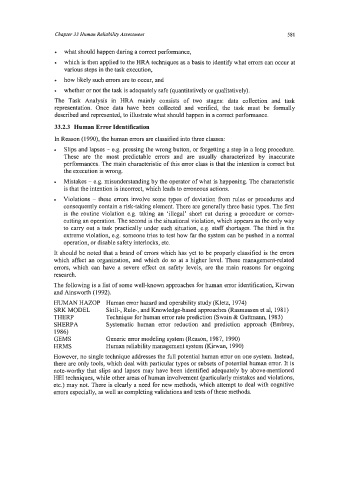Page 605 - Marine Structural Design
P. 605
Chapter 33 Human Reliability Assessment 581
what should happen during a correct performance,
which is then applied to the HRA techniques as a basis to identify what errors can occur at
various steps in the task execution,
how likely such errors are to occur, and
whether or not the task is adequately safe (quantitatively or qualitatively).
The Task Analysis in HRA mainly consists of two stages: data collection and task
representation. Once data have been collected and verified, the task must be formally
described and represented, to illustrate what should happen in a correct performance.
33.2.3 Human Error Identification
In Reason (1 990), the human errors are classified into three classes:
Slips and lapses - e.g. pressing the wrong button, or forgetting a step in a long procedure.
These are the most predictable errors and are usually characterized by inaccurate
performances. The main characteristic of this error class is that the intention is correct but
the execution is wrong.
Mistakes - e.g. misunderstanding by the operator of what is happening. The characteristic
is that the intention is incorrect, which leads to erroneous actions.
Violations - these errors involve some types of deviation from rules or procedures and
consequently contain a risk-taking element. There are generally three basic types. The first
is the routine violation e.g. taking an ‘illegal’ short cut during a procedure or comer-
cutting an operation. The second is the situational violation, which appears as the only way
to carry out a task practically under such situation, e.g. staff shortages. The third is the
extreme violation, e.g. someone tries to test how far the system can be pushed in a normal
operation, or disable safety interlocks, etc.
It should be noted that a brand of errors which has yet to be properly classified is the errors
which affect an organization, and which do so at a higher level. These management-related
errors, which can have a severe effect on safety levels, are the main reasons for ongoing
research.
The following is a list of some well-known approaches for human error identification, Kirwan
and Ainsworth (1992).
HUMAN HAZOP Human error hazard and operability study (Kletz, 1974)
SRK MODEL Skill-, Rule-, and Knowledge-based approaches (Rasmussen et al, 1981)
THEW Technique for human error rate prediction (Swain & Guttmann, 1983)
SHERPA Systematic human error reduction and prediction approach (Embrey,
1986)
GEMS Generic error modeling system (Reason, 1987,1990)
HRMS Human reliability management system (Kirwan, 1990)
However, no single technique addresses the fill potential human error on one system. Instead,
there are only tools, which deal with particular types or subsets of potential human error. It is
note-worthy that slips and lapses may have been identified adequately by above-mentioned
HE1 techniques, while other areas of human involvement @articularly mistakes and violations,
etc.) may not. There is clearly a need for new methods, which attempt to deal with cognitive
errors especially, as well as completing validations and tests of these methods.

